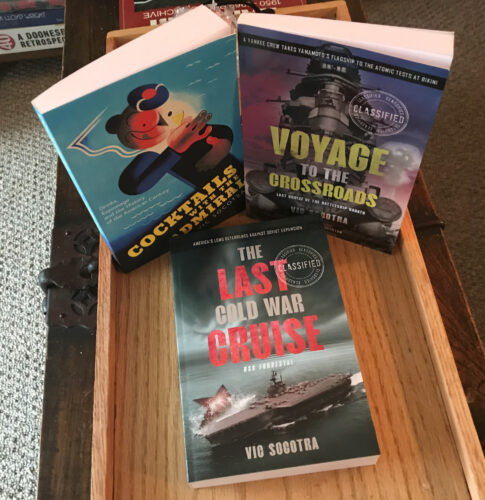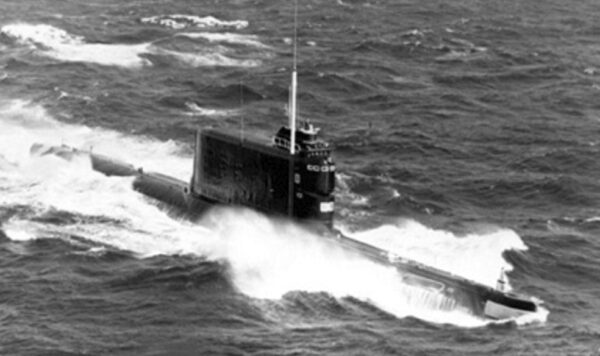Sea Stories

(Clockwise are the recent New Works from Socotra House. “Cocktails With the Admiral” is a compilation of the collected thoughts of RADM Mac Showers from his arrival at Pearl in February of 1942 with the big ships still on the bottom. That collection of sea stories was followed in short order by “Voyage to the CROSSROADS,” a timely account from a participant in the Atomic testing in the Pacific in 1946 and the establishment of the Cold War scheme of international relations. The latest is about the end of that time in the Med, and the announcement that the Soviet Union was done with it at the Malta Saltwater Summit in 1990.)
Editor’s Note: The was a near riot at the Content Generation meeting on Sunday. Not an unpleasant one, of course, since we are all gentle people. The matter rose directly from a discussion about the Next Book. Management sent a short memo indicating the lay-out and composition shop in Arizona was ready to go on the next project. We are still a little breathless about that.
The memo claimed that the Company has actually invested cash money on the next project, and we are still teetering on what it might be. We have some memories to wade through. A dozen years ago we were still able to talk to a few Admirals who had actually lived the tales they told. The one that follows is among them. It comes from an account of the life and times of Vice Admiral Earl F. “Rex” Rectanus, USN-Ret. It turned up in a massive shifting of files between The Farm and Federal Virginia. The point of the narrative was to capture the imperative of the times, and the urgency imposed by the way the system worked then. One of the check-list items for dealing with it were the safe procedures to “guard against inadvertent release or utilization of weapons that could destroy civilization.”
We will see where that goes, since we seem to be living it again without the Grown Ups.
– Vic
09 January 2010
Sea Story

(Red Banner Pacific Ocean Fleet Golf-class Ballistic Missile Submarine).
Oh Lord, this is a complicated business. I wish I could have just asked Rex a couple questions when I had the chance, but we were working on other things. Then the way of the world took him and left only life’s punctuation mark on him and his.
Our pal Mac was alive then, and he said he had dinner with Rex and Admiral Bud Zumwalt in Saigon in December 1969. It is a good date, since his impeccable records contain his travel claim for the trip and the accompanying memo ordering him to report as Chief of Staff of the Defense Intelligence Agency in early January 1970.
Our alert reader base swung into swift and decisive action to support an accurate accounting of the time. According to Larry Berman, Rex was on the CINCPACFLT Staff of Admiral Ulysses Grant Sharp in 1966, departing for the Republic of Vietnam in May of 1968 and returning to the continental United States in June of 1969.
I trusted Mac’s memory and his impeccable documentation, so his presence in Vietnam in December of 1969 is a mystery to me. Rex had been properly relieved by CAPT Bob Pyle; I had his phone number from a helpful source and called him up to see if Rex made a trip back to the war environment he did so much to mold.
But as I have said before, the world never allows you to concentrate on one thing, and after a relentless focus on infiltration routes and Cambodian sanctuaries, Rex had to concentrate on events elsewhere in the Pacific.
The month before Rex reported to lovely Hawaii, something big was happening in the Mid-PAC, something that he would never be able to talk about. That may have been one of the reasons that the quest to honor Jack Graf meant so much to him. The events of a lost war were all out there, and with the passage of time, nearly everyone who had something to say about the War, and Jack’s part of it has done so.
Rex wanted us to remember the sacrifice of a generation through the lens of one man. He knew how rapidly and intentionally we forget other things.
We talk about similar efforts that may be happening right now. It is about something else, an operation that in its way was as expensive, complex and technically innovative as the Moon Shot. Rex would wind up in the middle of it as the Director of Naval Intelligence. It was nothing he could talk about, and in all the years after, he never did.
I have to say something right here. Everything from this sentence- call it a tear line, like we used to in the business- is from open source, readily available information. I do not endorse, vouch for accuracy, have any personal knowledge of, nor involvement in the matter. How is that for a disclaimer?
Think of it as a Sea Story, if you will.
You know the difference between a sea story and a fairy tale don’t you? Bedtime stories start out “Once upon a time.” A sea story starts out “This is a no-shitter….”
So, this is no shit. Really happened. Maybe.
The development of the Sound Surveillance System (SOSUS) added important new capabilities to U.S. Navy efforts to identify and locate Soviet submarines armed with strategic nuclear missiles. The Navy Scientific and Technical Intelligence Center (NAVSTIC) was established to integrate information harvested from the world ocean with that collected by the Naval Field Operational Intelligence Office (NFOIO) at Fort Meade.
In context, our pal Sid Wood was Chief of the Electronic Warfare Intelligence Branch as a LT from Summer 63 till Feb 65. He had been ordered there by Rex before his two years were up on the Staff of Amphibious Group One, home-ported in Subic Bay, Republic of the Philippines. He wrote Rex a note telling him he wanted to finish his sea tour (which would have been in September or October ’63), advising him that his wife Nancy was very pregnant expecting the birth of their first-born. Rex wrote back a response to tell Sid “We don’t always get what we want,” but he did delay the move for some weeks so the baby would be born at Cubi Point.
Sid Jr. was born 26 March, and six weeks later the family was on the way back to CONUS.
The Scientific and Technical Intelligence Center (STIC) was then located on the grounds of the Naval Observatory right behind the CNO’s quarters- the house subsequently appropriated for the Vice President’s use.
High-speed dedicated communications lines connected Suitland, the Pentagon and the Atlantic and Pacific Fleet intelligence centers. They had been in place and connected through the ONI ADP Center at Arlington Hall Station, right across the street from my our once-and-present residence at Big Pink.
The goal of the connectivity was lofty. Naval Intelligence intended to track every maritime unit of interest on the world ocean, and particularly the highest value units of them all: the Soviet boomers, the silent carriers of ballistic missiles targeted against America’s cities, including the one in which I lived. It made a world geolocational problem strangely personal.
In April 1968, some highly unusual activity was noted in the mid-Pacific. Soviet Red Banner Pacific Fleet surface and air aircraft were observed conducting a “surge deployment.” That is one in which all the component parts of a military machine are put in motion in the same manner it would be in a time of conflict with a world at stake. It is one of the most intense analytic challenges that exist in the ocean surveillance business, since dispersal was considered to be the onlyindicator of impending hostilities.
Or, it could be a perfectly normal exercise of the system to ensure that it could work as intended. This dispersal did not appear strategic in nature but it involved unusual operations in the North Pacific. Analysts in Suitland, Maryland, and Pearl Harbor poured over the information. SOSUS elements were tasked with an exhaustive review of the sonograms covering the period. Naval Facility (NavFac) Point Sur, south of lovely Monterey, was able to isolate a unique sonic low-frequency event at midnight on 08 March 1968. Using that point of time as datum, five line-of-bearing hits were able to identify a likely area northeast of Hawaii as the location for a highly unusual event.
It was. The sounds reflected the loss of a Golf-class ballistic missile submarine, probably K-129. She was lost with all hands, and three nuclear-tipped SS-N-5 Serb missiles fell with the wreckage to the sea floor.
Despite weeks of intense effort, the Soviets were unable to locate the wreck, and slowly activity levels returned to normal levels. The Bear was nervous about what they had lost- the launch platform, code machines, and long range nuclear-tipped rockets the boomer carried. But there was not a damned thing they could do about it.
It was time for our Navy to check things out. The former Regulus cruise missile submarine USS Halibut (SSGN-587) was dispatched from Pearl Harbor to search the likely area in the Soviet diesel patrol box. Halibut almost miraculously located the wreck after only three weeks of searching. Thousands of detailed pictures of the wreck were acquired, analyzed and packaged by Naval Intelligence analysts to provide meaning and context of the event for decision-makers up the chain of command.
To say that the highly classified material was electrifying is an understatement. The latest technology of the Main Enemy’s strategic reserve was strewn across the ocean floor.
Lyndon Johnson signed out at Presidential Unit Commendation in recognition of Halibut’s accomplishment, the public version of which was carefully worded to disclose nothing.
In 1970, based on the evidence of what was on the seafloor, SECDEF Melvin Laird and National Security Advisor Henry Kissinger talked about what a trove of information was lying there, three miles down on the ocean floor. Nuclear weapons. Rocket technology. Code books.
No salvage activity had ever been conducted in water that deep. They devised a covert plan to recover the wreckage, which was accepted by President Nixon, just as Rex was getting ready to take over the Office of Naval Intelligence.
The CIA was tasked to attempt the recovery, but of course they had to use the expertise of the Navy, and Naval Intelligence was in the middle of the whole thing.
The press talks about it as Project Jennifer, but that is not what it was. You can find out easily enough, if you care to look. I am not going to touch that one with a three-mile long pole.
That is a no-shitter. That is how they start, and you can fill in the background with the sweeping service bar at The Willow restaurant, the crowd of usual suspects, and maybe a started gasp from the lovely lady on the service side of things!

Copyright 2023 Vic Socotra
www.vicsocotra.com
